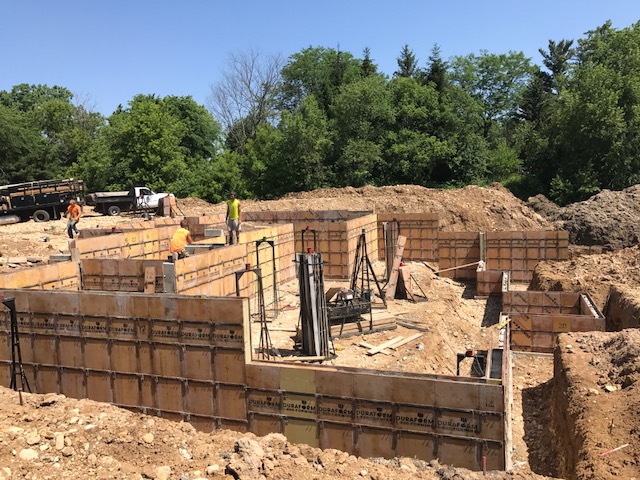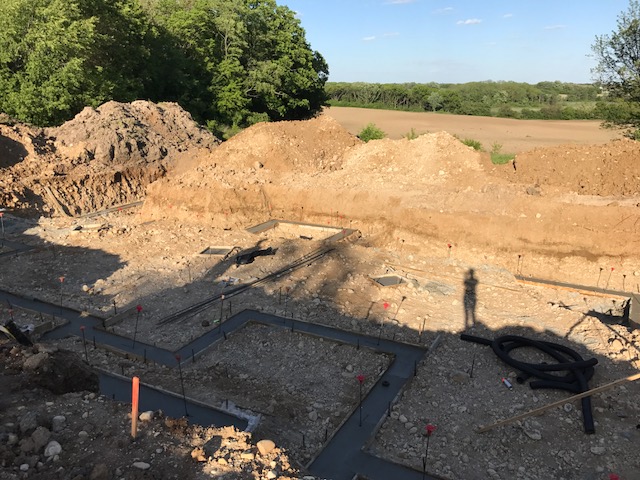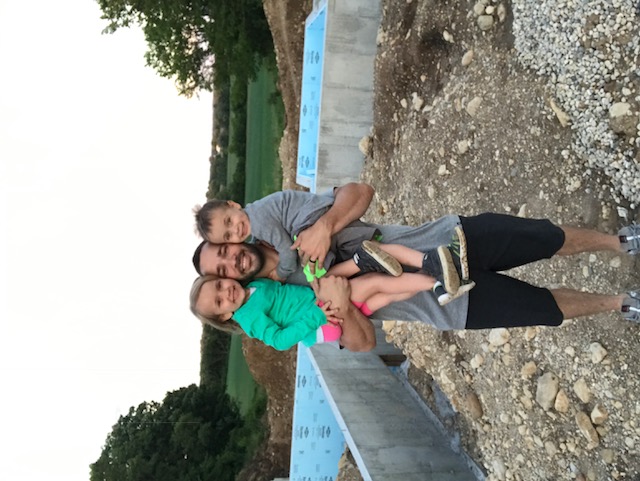
It may sound cliché, but starting your home on a good foundation is a crucial first step in building. This means making sure that your house gets placed according to plan on the lot, that it’s set at the correct elevation, and that all of the walls are square. It sounds easier than it really is. Before building my own home, I had no clue what all went into building a foundation. This may be a step of the building process where you rely heavily on your builder to make sure that this part is getting taken care of correctly. I know that we did! Your builder should start by meeting your foundation contractor on site. This way they can go over the house placement and talk more about wall heights and elevation. Especially if your home has zero-step entry, the garage floor and house floor need to come in at the exact same level. During this step, it’s also the last chance to put in a trench drain in your garage if you want to.

Let’s take a minute to talk about what a trench drain is. It’s a drain system in your garage floor that runs parallel to the front of your garage. You’ve probably seen them a bunch of times, but might not have considered what they are for. The drain can be piped to the city sewer (if you live on a city lot) your septic (if you live in the country), or simply “to daylight” which means that the water drains to somewhere in your yard via piping. You’d put this in your garage in place of a circle drain, which requires that the concrete be pitched to the center of your garage for proper drainage; making your garage floor uneven. A trench drain actually runs the width of your garage floor so that all of the water slopes to it and when you park your vehicle in the garage, it sits on flat concrete. At Sockness Builders, we encourage our clients to do a trench drain in their garage if they can. It’s a great option, especially for us Wisconsinites. When the winter slush, ice, and snow melts off of your vehicle in the garage it can easily and neatly melt into the trench drain.

Anyway, let’s get back on track… when starting the foundation for your home, the footings come first. Footings are a concrete base that your foundation walls sit on. Our foundation contractors typically use Form-A-Drain® as a means of controlling water that might seep in next to the foundation, and this becomes the form for the footings. It works just like drain tile, but puts the channel for water below the basement floor. This is typically connected to a sump crock in the basement where water is then collected and pumped outside in the event that you would have some type of flooding. When we use Form-A-Drain® it’s because the soil conditions on a lot are mostly clay, which doesn’t allow proper drainage into the ground. The next component of this system is then to put 6” of clear stone underneath the basement slab. This creates the drainage field that controls any excess water that gets into the system. Sometimes, the soil conditions where a house is being built are mostly sand. This is ideal for drainage and in some instances, a system like drain tile or Form-A-Drain® aren’t needed.

The concrete foundation walls of your new house then get poured on top of the footings. This is your first chance to really see your house take shape. If you’ve ever built before, then you’ve probably stood at the top of the excavated basement hole in amazement… thinking that you must’ve signed on to build a mansion because it looks HUGE. Once the foundation walls get poured, the shape comes to life and things start to come into perspective. The foundation walls are almost always pumped or conveyed into place. If you’re building a new house, this is another cost to make sure that you’ve considered or that your builder has told you about, so that you aren’t surprised in the end.
The next day after the foundation wall pour, the forms can come off. We allow the foundation walls to sit for 10 days prior to backfilling (which is when the fill from the basement dig gets placed up against the house). The reason for this is because the concrete needs time to cure and set. During the waiting time, your contractor might break off wall ties, tar the holes or apply a foundation coating, and install foam on the new exterior walls. Lastly, if the excavated materials on your lot are mostly clay, then you may need to import granular material for filling the garage and porches of your soon-to-be house. We always make sure that the material in these areas are good quality and then either compacted or soaked with water before the garage or porch floors are poured. It’s super import to in making sure that these areas don’t settle over time.
#socknessbuilders #socknessbuildersinc #fromthegroundup #fromthegroundupblog #newhomeconstruction #remodeling #southernwihomebuilder #listendesignbuild #rockcountywihomebuilder #newhomebuilder #contractor #foundation #newhomefoundation #foundationwalls #trenchdrain #formadrain #foundationwalls #buildinganewhouse #buildinganewhome


